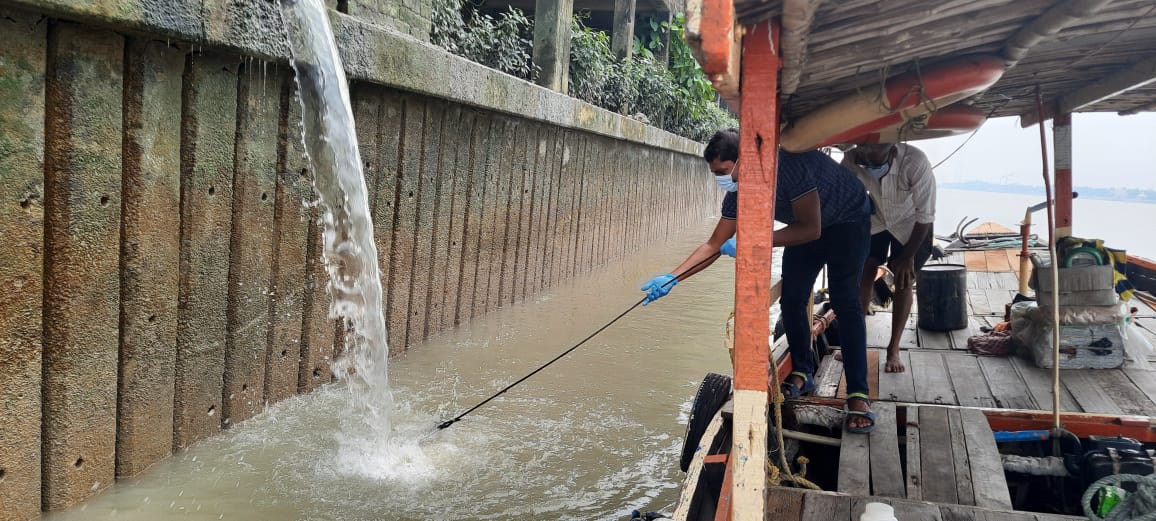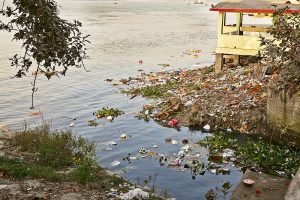The Indian government’s efforts to clean the Ganga River, considered holy by millions of Hindus, could require greater efforts. New research reveals that the river’s lower stretch is the most polluted, with glaring evidence of algal bloom and signs of eutrophication compared to the middle or upper zones.
Eutrophication is the process by which the water body becomes excessively enriched with nutrients, leading to an increase in the production of algae and macrophytes.
The research study, which The Diplomat has seen, reveals the poor quality and sewage runoff in the lower stretch of the river. This was the first study that quantified the true extent of pollution in terms of water quality index and algal bloom in the lower stretch of the river. Algal bloom on such a large scale had not been reported earlier.
The research, which was undertaken by scientists at the Kolkata-based Indian Institute of Science Education and Research, was funded by the Water Technology Initiative of the government’s Department of Science and Technology. Its findings have been submitted to the government.
Scientists engaged in the research believe that this would have a negative impact on biodiversity in the region, including the World Heritage Site of the Sundarbans, as well as damaging the ecological health of the Ganga River Basin. It could also cause diseases for the pilgrims who bathe in the river at places such as Dakshineswar.
The river’s poor water quality could have “long-term adverse ecological consequences on the aquatic ecosystem of the river, including on higher trophic levels such as resident fish populations,” the study says.
According to Punyasloke Bhadury, who led the team of researchers, “Overall, this will compromise the bigger objectives of the National Mission for Clean Ganga.”

Scientists collecting water samples from the Ganga River in West Bengal. Photo by Punyasloke Bhadury.
The National Mission For Clean Ganga acts as the implementation arm of the National Ganga River Basin Authority (NGRBA), which was constituted under provisions of the Environment Protection Act (EPA), 1986. The operational area of this project comprises the Ganga basin and all the states through which the river flows. The objective is to reduce pollution and ensure the rejuvenation of the Ganga River.
Speaking to The Diplomat, Bhadury pointed out that the “lower stretch of the [Ganga] river is undergoing rapid deterioration due to the release of untreated municipal sewage. For effective management of the Ganga River Basin management, there is an urgent need to look at the state of non-functional sewage treatment plants. More investments are required.”
A previous study by the research team had developed benchmarks for understanding water quality of the lower stretch of the Ganga River, while the present study “focused on the consequences of deteriorating health on the river ecosystem,” Bhadury said.
From its origin in the Himalayas, the Ganga River traverses 2,500 kilometers before meeting the Bay of Bengal. As the river enters its last stretch in West Bengal in eastern India, there is a rapid increase in width along with a decrease in flow rate, which is further regulated by barrages, including the Farakka Barrage.
Downstream of the Farakka Barrage, the Ganga splits into two branches — the Bhagirathi-Hooghly, which flows through the state of West Bengal and drains into the Bay of Bengal, and the Padma River, which flows into Bangladesh before emptying its waters in the Bay of Bengal.
The research identified natural disturbances and extensive population growth as the factors causing the pollution of the river. Discharge of wastewater has led to an increase in fecal coliform counts, especially in the stretch between Dakshineswar and Diamond Harbor sectors of West Bengal.
The findings put a question mark on the Indian government’s National Mission For Clean Ganga, which has already implemented a slew of schemes for cleaning the river, wastewater treatment, solid waste management, maintaining continuous flow, rural sanitation, biodiversity conservation, etc. So far 364 projects have been sanctioned at an estimated cost of $3.85 billion, out of which 183 projects have been completed and made operational.
In 2019, Minister for Jal Shakti (literally water power) Gajendra Singh Shekhawat informed Parliament that there has been an improvement in the quality of water in the Ganga River. Last month, the government took a $13.26 million loan from the Austrian Development Bank for a sewerage treatment project in West Bengal.
The research is further testimony of the river’s contribution to polluting the Bay of Bengal. Last year, an international team of scientists that was part of the National Geographic Society’s “Sea to Source: Ganges expedition” concluded that between one billion and three billion microplastics are being released from the Ganges Brahmaputra Meghna River Basin every day into the ocean.

































